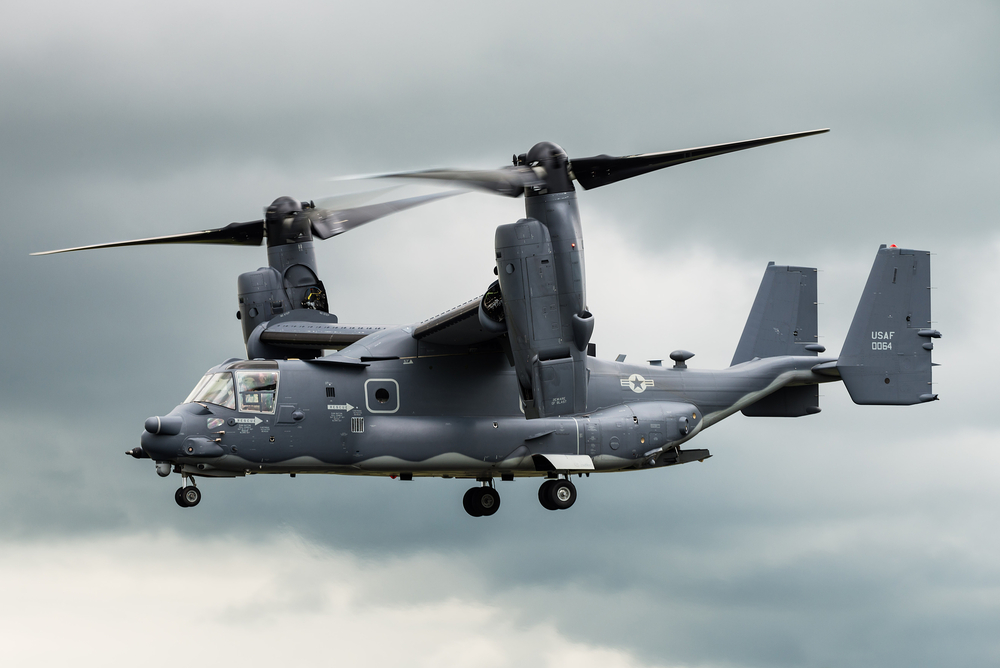V-22 Osprey Infographic showcases information on one of the world’s most powerful and dynamic VTOL/STOL military transport aircraft—current users of the aircraft include the United States Marine Corps, the United States Air Force, and United States Navy, with Japan officially signed on as the first official export customer
The Supreme Guide to the Bell Boeing V-22 Osprey Inforgraphic was created using information that was compiled from Wikipedia’s “Bell Boeing V-22 Osprey” article. It highlights the aircraft’s vital statistics, general specifications, and key performance outputs.
The Bell Boeing V-22 Osprey is an entirely unique multi-mission combat aircraft that is manufactured by a joint-service partnership between Bell Helicopter and Boeing Rotorcraft Systems. It achieved first flight on March 19th, 1989, and was introduced into service on June 13th, 2007. This aircraft was designed around the concept of combining the vertical functionality of a conventional helicopter with the high-speed and long-range outputs of a turboprop aircraft. As a result of its fixed-wing and rotary-wing functionality, the V-22 is well-known for its vertical takeoff and landing (VTOL), as well as short takeoff and landing (STOL) capabilities. It is this versatility and robustness that makes the V-22 the aircraft of choice for a variety of challenging roles.
In addition to direct combat, the V-22 has the capacity to successfully complete search and rescue missions, provide humanitarian assistance, facilitate aircraft carrier on-board delivery, and can assist with military logistics (ex. the transportation of troops and equipment). Along with that, the V-22 has been built with aerial refueling capabilities, which effectively extends the overall range of the aircraft, allowing it to participate in more lengthy missions. Upon landing, the aircraft’s foldable rotors and rotatable wings make for easy storage and allow for the maximization of space.
For speedy reference, an abbreviated summary of infographic data is located below the image.
(Click on the image to zoom into the material)
The Supreme Guide to the Bell Boeing V-22 Osprey Infographic Summary
Introducing the Bell Boeing V-22 Osprey
The Bell Boeing V-22 Osprey is an American-made, mulit-mission, tiltrotor military aircraft with vertical takeoff and landing (VTOL), and short takeoff and landing (STOL) capabilities.[2]
The aircraft design was based around the concept of combining the functionality of a conventional helicopter with the long-rang, high-speed cruise performance of a turboprop aircraft.[4]
Vital Statistics[5]
- Aircraft Role: VTOL/STOL Military Transport Aircraft
- Manufacturer: Bell Helicopter; Boeing Rotorcraft Systems
- First Flight: March 19, 1989.
- Introduction: June 13, 2007.
- Current Status: In Service
- Production Period: 1988-Present
- Number Built: 200+ as of 2014
- Unit Cost: MV-22: US$72.1 million (flyaway cost for FY2015)
- Developed From: Bell XV-15
General Characteristics[7]
- Crew: Four (Pilot, Copilot and two Flight Engineers/Crew Chiefs)
- Capacity: 24 troops (seated), 32 troops (floor loaded), or
20,000 lb (9,070 kg) of internal cargo, or up to 15,000 lb (6,800 kg) of external cargo (dual hook), or
1× Growler light internally transportable ground vehicle - Length: 57 ft 4 in (17.5 m)
- Rotor Diameter: 38 ft 0 in (11.6 m)
- Wingspan: 45 ft 10 in (14 m)
- Width with Rotors: 84 ft 7 in (25.8 m)
- Height: 22 ft 1 in/6.73 m; overall with nacelles vertical (17 ft 11 in/5.5 m; at top of tailfins)
- Disc Area: 2,268 ft² (212 m²)
- Wing Area: 301.4 ft² (28 m²)
- Empty Weight: 33,140 lb (15,032 kg)
- Loaded Weight: 47,500 lb (21,500 kg)
- Maximum Takeoff Weight: 60,500 lb (27,400 kg) (self-deploy/long runway)
- Maximum Rolling Takeoff Weight: 57,000 lb (STOL)
- Maximum Vertical Takeoff Weight: 52,600 lb (23,859 kg)
- Powerplant: 2 x Rolls-Royce Allison T406/AE 1107C-Liberty Turboshafts, 6,150 hp (4,590 kW) each
Performance[10]
- Maximum Speed: 275 knots (509 km/h, 316 mph) at sea level / 305 kn (565 km/h; 351 mph) at 15,000 ft (4,600 m)
- Cruise Speed: 241 kn (277 mph, 446 km/h) at sea level
- Stall Speed: 110 kn (126 mph, 204 km/h) in airplane mode
- Range: 879 nmi (1,011 mi, 1,627 km)
- Combat Radius: 390 nmi (426 mi, 722 km)
- Ferry Range: 1,940 nmi (2,230 mi, 3,590 km) with auxiliary internal fuel tanks
- Service Ceiling: 25,000 ft (7,620 m)
- Rate of Climb: 2,320–4,000 ft/min (11.8 m/s)
- Glide Ratio: 4.5:1
- Disc Loading: 20.9 lb/ft² at 47,500 lb GW (102.23 kg/m²)
- Power/Mass: 0.259 hp/lb (427 W/kg)
Track and Manage Complex Aircraft like the V-22 Osprey with Ease in WinAir
With WinAir Version 7, the latest release of the award-winning company’s software solution, you can track and manage the maintenance activities on any aircraft with ease. The software has the capacity and flexibility to manage even the most complex multi-engine aircraft-types, like that of the Bell Boeing V-22 Osprey.
Regardless of the size of your operation, or the types of aircraft that you command in your fleet, with WinAir Version 7, you can anticipate that business processes will be expedited and maintenance procedures will be simplified. This will lead to an improvement in your operational efficiencies, which can save both time and money in the long run.
Since the release of WinAir Version 7, aviation operations worldwide have commented on how the software has seamlessly integrated with their current work environment and has increased their overall business productivity. They have also expressed that they are benefiting from the software’s robust capabilities, data validation functionality, and sequential workflow. This has resulted in significant cost savings and efficient gains for their respective operations.
Are you interested in learning more about the business benefits of WinAir? If so, then contact us now to discuss scheduling your time for a tailored demonstration of WinAir Version 7!
About WinAir:
Based in London, Ontario, Canada, WinAir has 30 years of experience as a leader in aviation management software. Companies rely on WinAir to efficiently and effectively track and manage aircraft maintenance and inventory control. WinAir is proud to lay claim to hundreds of installations at aviation-specific organizations worldwide. From airlines, to heli-ops, to law enforcement agencies, oil industry suppliers, MROs, CAMOs, medical evacuation response teams and more, businesses using WinAir regard the solution as a necessary component to the successful management of their fleet maintenance programs.






